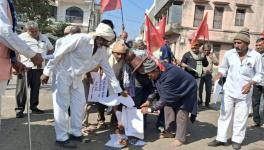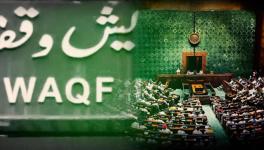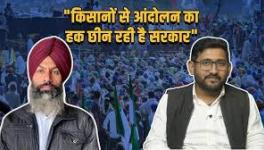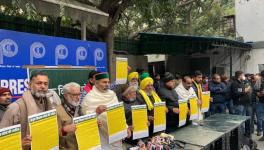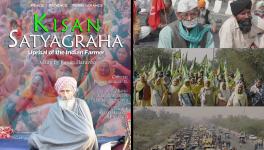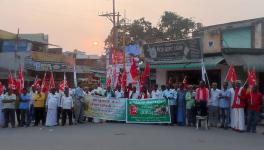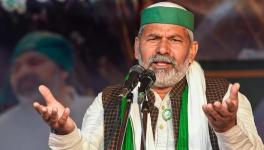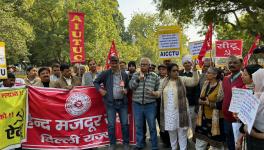Farm Laws: How a Peaceful Farmers’ Parade Turned Violent
New Delhi: It was about 11:30 am (at least 30 minutes before the pre-decided time) when thousands of farmers – primarily from western Uttar Pradesh and Uttarakhand – riding hundreds of tractors and trolleys, began marching as part of their Republic Day parade on their designated route — Ghazipur border-Apsara border-Hapur Road-Bhopra-IMS College-Lal Kuan-Ghazipur border — on January 26.
The police had erected the first layer of barricade – a green Delhi Transport Corporation bus – on the elevated Delhi-Meerut Express Highway, a few metres away from the Ghazipur protest site. Asked about the logic behind blocking the designated road, a senior officer explained: “We want farmers to take out their parade in a long line so that its smooth passage can be ensured. The farmers are expected to use the narrow lane below the elevated road, both of finally merge into one wide stretch.”
The road leads to UP Gate which further leads to three different routes — Akshardham is straight ahead, a right turn leads to Anand Vihar and the left to Vaishali. It had been decided that the agitating peasants’ contingent would take the right turn from the UP Gate trisection onto the designated route.
There were a large number of people and their tractors. While a group of protesters camping in one lane of the elevated road, with its vehicles positioned towards the designated route, began marching ahead instead of going back towards Ghaziabad and taking a U-turn to move on the narrow lane below the flyover, the other group camping below the flyover started moving straight on the road, following the approved route from the lane below.
So far, there were no problems and the march was peaceful, with farmers raising slogans ‘Jai Jawan, Jai Kisan’ (victory for soldiers, victory for farmers). Those, especially youngsters, who had started from the elevated road to march ahead, lost their cool after they spotted the DTC bus parked on their designated route. They first tried to move ahead by pushing the bus with their tractors. Later, a large number of them pushed the bus to the left and made their way.
Dozens of policemen were deployed at the spot, but keeping the protesters’ aggression and their numbers in mind, they maintained restraint and allowed the rally go ahead.
The problem started when the two groups reached the UP Gate trisection. The police had blocked their way by erecting iron barricades few metres before they were supposed to take the right turn for Anand Vihar, the designated route. The apparent reason behind barricading the road was that the police perhaps wanted them to take the first right (wrong lane) from the barricade instead of allowing them to move a little ahead and take a right turn (correct lane).
Notably, the two lanes lead to Anand Vihar and are separated by an underpass. The confrontation could have been avoided if the protesters had been allowed to use both lanes as there was no traffic and the route was completely sanitised.
The altercation between the police force and the protesters began – for the first time – at that barricade. The farmers were trying to breach the blockade and the policemen, including female police officials, were stopping them by standing in front of their tractors, daring the agitating farmers to run over them.
As the dispute between the two sides was about to take a violent turn, Bharatiya Kisan Union (BKU-Tikait) leader Rakesh Tikait intervened. To first pacify the protesters, he pushed behind several youngsters who were trying to break the barricade. He asked the aggressive youths to let him talk to senior police officers stationed there. At one point Tikait and his men lathi-charged the youth who were not ready to obey him.
Once they stopped for a brief moment, he came down heavily on Additional DCP Sukant S. Ballabh for allegedly “provoking” and “inciting” violence by barricading the designated route. “Tumne kyun lagaya barricade jab iski ijazat thi? Danga karwana chahte ho? (Why did you put the barricade on the route which was approved to be used for the parade? Do you want violence?),” he was heard saying.
The police force then withdrew and the protesters marched ahead by bringing the barricades down. Tempers were already running high over the government sticking to its position that the three contentious Farm Laws, which are being vehemently opposed across the country, would not be repealed at any cost. The government is ready to amend the legislation and even halt its implementation for 18 months till a consensus is reached between the two sides.
As they moved on, the protesters encountered a third-barricade layer which was erected a little ahead of the trisection, blocking the road to Akshardham with an empty container. A huge police force in riot gear was deployed there. As the rally progressed on the designated route after the brief altercation, a handful of protesters, riding around 15 tractors, flouted the designated route. They dragged the container to a corner and marched ahead towards Akshardham, instead of going on the approved diverted route.
Here again Tikait intervened, ensuring the protesters respected the designated route. After the majority of the farmers progressed on the designated route, a final batch of the protesters, adamant to go Akshardham and then enter Delhi’s Outer Ring Road through Sarai Kale Khan, clashed with the police. The security forces resorted to tear-gas shelling and a baton charge to disperse them. Following nearly an hour of persuasion and efforts, the protesters were finally diverted onto the designated route. Those who had manged to march towards Akshardham then reached ITO, where they were also joined by protesters who had reached there from other protest sites at the doorstep of the national capital, breaching several layer of barricades.
Heavy clashes took place between the agitators and security personnel, with both sides using force to dominate the other. Thirty-six-year-old Navneet Singh was killed in the clash after his tractor overturned. Circumstances leading to his death are yet to be confirmed as the police say his speeding tractor met an accident while he was attempting to break a barricade while the protesters claim the accident took place after a tear gas shell hit him, resulting in him losing control over the vehicle.
Following the tear-gas shelling and the lathi charge, the police managed to secure the highly-sensitive area of Lutyens’ Delhi, which was a barricade away from the ITO. The protesters then moved towards Delhi Gate to reach Red Fort. Through Bahadur Shah Zafar Marg, the protesters (with some of them riding tractors, while others on foot) crossed Delhi Gate to move towards Daryaganj and the fort.
The police had barricaded the entrance to Daryaganj to divert the protesters to another route. Some of the tractors were diverted as well. However, the majority of them made their way to the Red Fort, with the police not attempting to stop them at that point. The agitators finally reached the Red Fort and hundreds of them climbed its ramparts. They unfurled Nishan Sahib (exalted ensign), a revered saffron flag of the Sikh community along with the flag of the Kisan Ekta Morcha (a joint front of striking farmer unions) on an empty pole at the rampart.
A few of them also reached the top of the fort and unfurled the same flags next to the central dome, which bore the Indian national flag.
The police initially used force to evict the protesters from the premises of the fort by lathi charging and tear gassing them. Not ready to budge, the agitators cornered the security forces there as well. They stayed there till late evening and then deserted the premises.
The farmers’ body condemned the incident, disassociating them from the protesters who were involved in the violence. They alleged that actor Deep Sidhu, who is said to be the election campaign manager of the Bharatiya Janata Party MP Sunny Deol, incited the protesters to indulge in violence. The actor-turned-activist is learned to have drawn flak from protesters for giving a communal colour to the farmers’ movement.
In videos circulating on social media, outraged farmers can be seen chasing him away from Singhu Border — one of the five gates to Delhi where farmers have been staging a peaceful sit-in for over 60 days. Sidhu has since owned up to hoisting the religious flag at the Red Fort.
Over 80 police personnel and several protesters have suffered injuries, with the condition of one of the cops said to be critical.
BKU’s Rakesh Tikait claimed to have identified a few “planted” trouble makers against whom action would be taken, he said. He also accused the government of creating ruckus to give out the message that the farmers indulged in violence.
“The police gave us the designated route late in the evening. As agreed, the cops were supposed to cooperate with us in ensuring no law and order situation arises. But we did not get any such cooperation from the police, which was expected to escort us; but that never happened. The designated route was barricaded to provoke the farmers. The government, which wanted to disrupt the peaceful protest, planted its people to create trouble. We have identified such people and action will be initiated against them,” he said.
Get the latest reports & analysis with people's perspective on Protests, movements & deep analytical videos, discussions of the current affairs in your Telegram app. Subscribe to NewsClick's Telegram channel & get Real-Time updates on stories, as they get published on our website.









